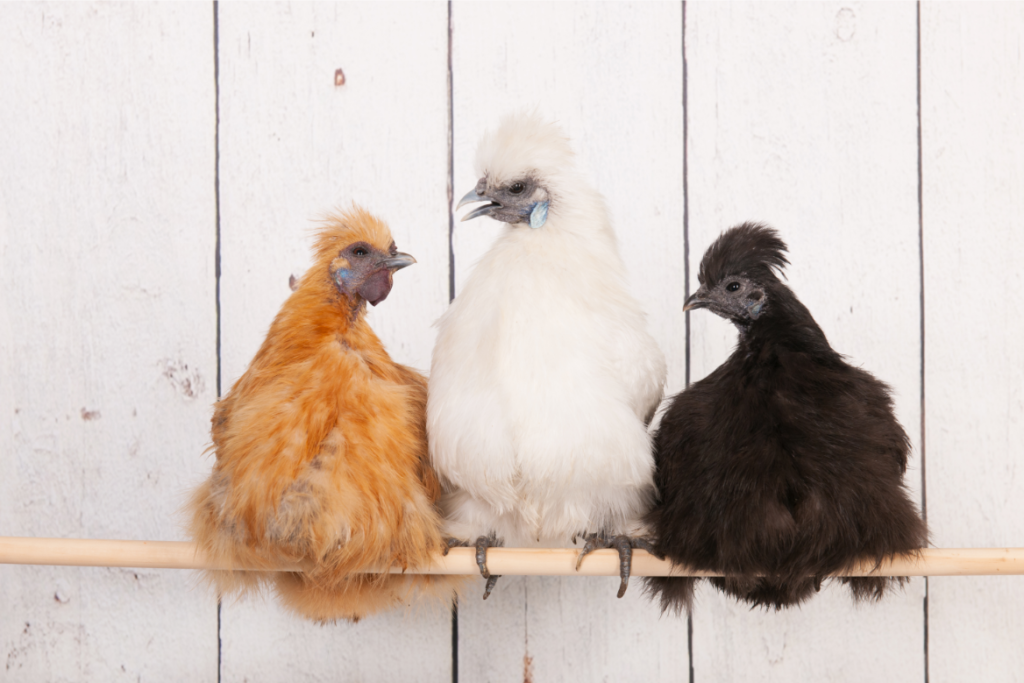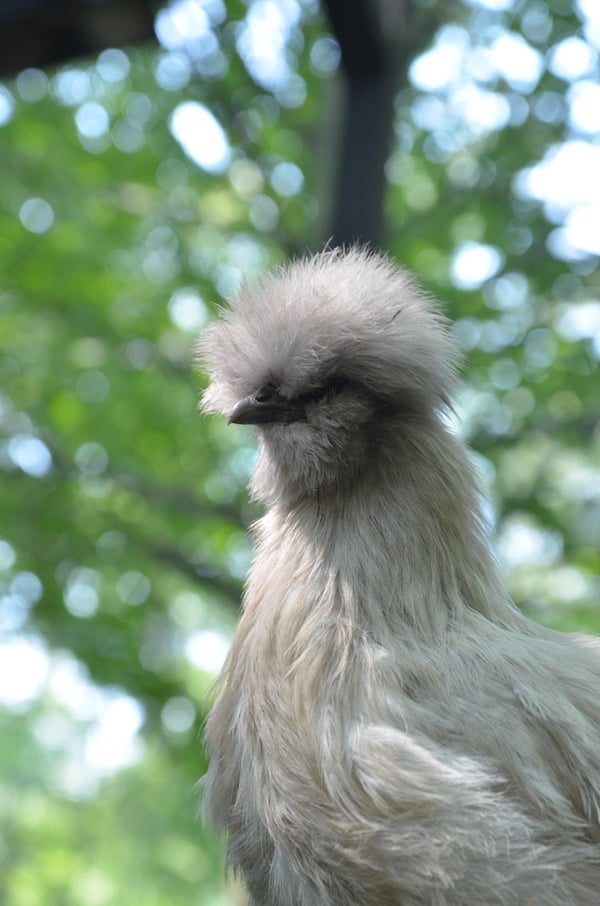The Silkie chicken is one of the most popular chicken breeds. With their bizarre features and loving personalities, they’re a favorite in backyard flocks everywhere.
Silkies are the most recommended chicken breed to be kept as pets and raised by children. Their sweet temperaments, soft feathering, and calm attitude make them true winners in the chicken world.
This post contains affiliate links.

Silkie Chicken Breed Profile
Silkies are interesting birds and differ greatly from other chicken breeds. Their features are truly one of a kind!
Physical Attributes:
Bantam
Silkies available in North America are bantams, meaning they’re a miniature version of standard chickens. They weigh about half that of a standard chicken, and their eggs about 2/3 the size of a your average egg. Standard sized Silkies are available in Europe, but haven’t made their way across the ocean just yet.
Beard, or no beard?
The presence of a muff of feathers around the ears and a beard under the chin is a Silkie breed standard for poultry shows and breeding programs. However, not all Silkies have these traits. Chicken keepers must take the time to seek out bearded silkie breeders if this is a desirable trait for their flock.
Silkie Feathers
Unlike most chickens, silkie’s feathers don’t have barbicels, which are like tiny hooks that hold the hairs of a feather together. This is why Silkies look so fluffy, the hairs are allowed to fly free. Silkies also grow feathers down their legs.

Skin, Toes, and Earlobes
Silkies have black skin and black bones. They are considered a delicacy in many parts of Asia, and some cultures believe the meat has healing properties. The meat of a silkie is a little darker than a standard chicken and has a richer, gamier flavor.
Silkies have a polydactyly gene, which results in an extra toe on each foot. This is a breed standard. Their extra toe appears on the back of their leg, much like the dewclaw on a dog.
Silkie earlobes are shockingly bright and iridescent, they’re colored turquoise or aquamarine.

Color Varieties
- White
- Buff
- Black
- Gray
- Blue
- Splash
- Partridge
- Lavender (not recognized by American Poultry Association)
- Cuckoo (not recognized by American Poultry Association)

Silkie Chicken History and Geography
Silkie Chickens are believed to have come from Asia. The oldest records of Silkie existence dates back to the 13th century, when Marco Polo wrote of these fluffy birds on his travels to China. He recorded that they had black skin and the hair of a cat.
Silkies have also been a favorite of many freak shows and scam artists. They were part of the traveling circus in the 1900s, touted as chickens with mammalian fur. It’s rumored that when Silkies were first sold in Western cultures, breeders tried to convince would-be buyers that they were a cross between a chicken and a rabbit.
Silkie Chicken Health Properties
The Chinese have been touting for hundreds of years that Silkie meat has healing powers, and just recently science has caught up with those claims. Silkie chicken meat is often eaten in China to treat anemia, postpartum disorder, diabetes, and to reinforce muscle strength and immunity. It’s usually the first thing given to a mother after she’s given birth to restore her health.
A research group at the Ministry of Education at Nanchang University conducted a study to measure the amounts of a naturally occurring peptide called carnosine in Silkies compared with that of White Plymouth Rock chickens.
Carnosine is best known for its ability to delay aging by protecting the tissues in the brain, heart, and eyes. The study found the Silkies to contain twice the amount of carnosine, proving that in fact, silkie chicken meat is better for you than standard chicken.

Silkie Chicken Physiology and Personality
Silkie chickens have quirky personalities. They’re very quiet and reserved, but can make quite the racket when sounding a predator alarm or laying an egg. Silkies are known for their good temperament and friendly disposition.
Silkies as Pets
Silkie Chickens make wonderful pets. They’re docile, friendly, and best of all: completely happy to be contained. Silkies don’t fly very well, so they can be kept in a chicken run or backyard with a relatively low fence. As stated earlier, they’re great with children and enjoy being held, pet, and fawned over.

Broodiness and Mothering
Silkies are well known for their broodiness, or desire to hatch chicks. They can go broody several times in a single season, and spend months out of the year sitting on a nest of eggs, waiting for chicks to pop out. Silkies make wonderful and caring mothers. They have even been known to adopt turkeys, ducks, quail, and other poultry as their own.
Egg Laying
Silkies are not amongst the top egg layers in the world. They will lay about 100-150 eggs per year on average. This is mainly due to the fact that they go broody so often, and hens don’t lay eggs when they’re in the broody cycle or while raising chicks. Egg laying numbers in Silkies really depend on the individual animal. Some will lay almost every day of the year, and some will lay only once a week.

Where to Buy Silkie Chickens
Silkies can be purchased from:
- My Pet Chicken
- Murray McMurray Hatchery
- Purely Poultry
Chicken Breed Guides
- Leghorn
- Wyandotte
- Chicken Breeds for Colorful Eggs
- Kid-Friendly Chicken Breeds
- Bantam Chicken Breeds
- Ameraucana
- Best Breeds for Beginners
- Polish

Lynn
Friday 1st of March 2019
When buying baby silky chicks, how do you know if it will be a fuzzy head or silk head?
Meredith
Sunday 24th of March 2019
You know that's a good question, and I have to say I haven't a clue! We've hatched a lot of silkies and I can't say I've noticed any difference in their appearances when they're little.
Alea
Wednesday 27th of December 2017
I have a silkie roo, midnight, hes a little over a year old. i find that silkies are very social and things, except when you have hens and other roosters. and if you don't trim the fluff around their eyes, they can become skittish, easily aggravated and mean, I always trip around his eyes. and they quite oftenly bound to a particular person. I know they love to be cuddled, but often deny it if they weren't handled much as a chick. feel free to email me if you have any questions, although I may not be of much help. aleaneilson@gmail.com
Beverly Nowlin
Friday 10th of February 2017
I have a blue gen she is so sweet going to buy more to raise I can go out to run and call her by her name which is fancy and she will run to me and squat down for me to pick her up she loves to cuddle my 3 yr old granddaughter loves her she can walk up to her and pick her up
Angi @ SchneiderPeeps
Wednesday 27th of May 2015
Silkies are so cute! We don't have any but our local zoo does. Thanks for sharing such a great profile of them.
Why Keep Silkie Chickens? - Homestead Lady
Wednesday 4th of March 2015
[…] Facts”. Here’s another of Meredith’s articles on Silkies but from her Backyard Chicken Project website, which is a great resource for all things backyard […]